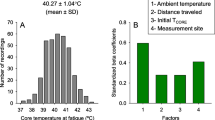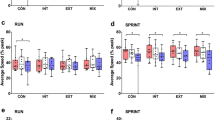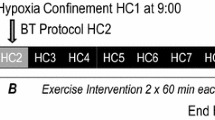Abstract
The mechanisms underlying physical exercise-induced hyperthermia may be species specific. Therefore, the present study aimed to investigate the effects of exercise intensity and ambient temperature on the core body temperature (T core) of running mice, which provide an important experimental model for advancing the understanding of thermal physiology. We evaluated the influence of different protocols (constant- or incremental-speed exercises), treadmill speeds and ambient temperatures (T a) on the magnitude of exercise-induced hyperthermia. To measure T core, a telemetric sensor was implanted in the abdominal cavity of male adult Swiss mice under anesthesia. After recovering from the surgery, the animals were familiarized to running on a treadmill and then subjected to the different running protocols and speeds at two T a: 24 °C or 34 °C. All of the experimental trials resulted in marked increases in T core. As expected, the higher-temperature environment increased the magnitude of running-induced hyperthermia. For example, during incremental exercise at 34 °C, the maximal T core achieved was increased by 1.2 °C relative to the value reached at 24 °C. However, at the same T a, neither treadmill speed nor exercise protocol altered the magnitude of exercise-induced hyperthermia. We conclude that T core of running mice is influenced greatly by T a, but not by the exercise protocols or intensities examined in the present report. These findings suggest that the magnitude of hyperthermia in running mice may be regulated centrally, independently of exercise intensity.





Similar content being viewed by others
References
Bland JM, Altman DG (2004) The logrank test. BMJ 328(7447):1073
Briese E (1998) Normal body temperature of rats: the setpoint controversy. Neurosci Biobehav Rev 22(3):427–436
Cheung SS, Sleivert GG (2004) Multiple triggers for hyperthermic fatigue and exhaustion. Exerc Sport Sci Rev 32(3):100–106
Davies B, Morris T (1993) Physiological parameters in laboratory animals and humans. Pharm Res 10(7):1093–1095
Fuller A, Carter RN, Mitchell D (1998) Brain and abdominal temperatures at fatigue in rats exercising in the heat. J Appl Physiol 84(3):877–883
Galloway SD, Maughan RJ (1997) Effects of ambient temperature on the capacity to perform prolonged cycle exercise in man. Med Sci Sports Exerc 29(9):1240–1249
Gant N, Williams C, King J, Hodge BJ (2004) Thermoregulatory responses to exercise: relative versus absolute intensity. J Sports Sci 22(11–12):1083–1090
Gonzalez-Alonso J, Teller C, Andersen SL, Jensen FB, Hyldig T, Nielsen B (1999) Influence of body temperature on the development of fatigue during prolonged exercise in the heat. J Appl Physiol 86(3):1032–1039
Gonzalez-Alonso J, Quistorff B, Krustrup P, Bangsbo J, Saltin B (2000) Heat production in human skeletal muscle at the onset of intense dynamic exercise. J Physiol 524(Pt 2):603–615
Gonzalez-Alonso J, Crandall CG, Johnson JM (2008) The cardiovascular challenge of exercising in the heat. J Physiol 586(1):45–53
Gordon CJ (2012) Thermal physiology of laboratory mice: defining thermoneutrality. J Therm Biol 37(8):654–685
Gordon CJ, Long MD, Fehlner KS, Stead AG (1986) Body-temperature in the mouse, hamster, and rat exposed to radiofrequency radiation—an interspecies comparison. J Therm Biol 11(1):59–65
Greenhaff PL (1989) Cardiovascular fitness and thermoregulation during prolonged exercise in man. Br J Sports Med 23(2):109–114
Guimaraes JB, Wanner SP, Machado SC, Lima MR, Cordeiro LM, Pires W, La Guardia RB, Silami-Garcia E, Rodrigues LO, Lima NR (2013) Fatigue is mediated by cholinoceptors within the ventromedial hypothalamus independent of changes in core temperature. Scand J Med Sci Sports 23(1):46–56
Jablonski NG (2010) The naked truth. Sci Am 302(2):42–49
Kanizsai P, Garami A, Solymar M, Szolcsanyi J, Szelenyi Z (2009) Energetics of fasting heterothermia in TRPV1-KO and wild type mice. Physiol Behav 96(1):149–154
Kuipers H, Verstappen FT, Keizer HA, Geurten P, van Kranenburg G (1985) Variability of aerobic performance in the laboratory and its physiologic correlates. Int J Sports Med 6(4):197–201
Lacerda AC, Marubayashi U, Coimbra CC (2005) Nitric oxide pathway is an important modulator of heat loss in rats during exercise. Brain Res Bull 67(1–2):110–116
Lieberman DE, Bramble DM (2007) The evolution of marathon running : capabilities in humans. Sports Med 37(4–5):288–290
Lima MR, Pires W, Fonseca IA, Fonseca CG, Martinelli PM, Wanner SP, Lima NR (2013) Chronic sympathectomy of the caudal artery delays cutaneous heat loss during passive heating. Neurosci Lett 537:11–16
Lind AR (1963) A physiological criterion for setting thermal environmental limits for everyday work. J Appl Physiol 18:51–56
Marino FE (2004) Anticipatory regulation and avoidance of catastrophe during exercise-induced hyperthermia. Comp Biochem Physiol B Biochem Mol Biol 139(4):561–569
Mount LE, Willmott JV (1967) The relation between spontaneous activity, metabolic rate and the 24 hour cycle in mice at different environmental temperatures. J Physiol 190(2):371–380
Nielsen B (1966) Regulation of body temperature and heat dissipation at different levels of energy- and heat production in man. Acta Physiol Scand 68(2):215–227
Nielsen B, Strange S, Christensen NJ, Warberg J, Saltin B (1997) Acute and adaptive responses in humans to exercise in a warm, humid environment. Pflugers Arch 434(1):49–56
Nybo L, Nielsen B (2001) Perceived exertion is associated with an altered brain activity during exercise with progressive hyperthermia. J Appl Physiol 91(5):2017–2023
Nybo L, Moller K, Volianitis S, Nielsen B, Secher NH (2002) Effects of hyperthermia on cerebral blood flow and metabolism during prolonged exercise in humans. J Appl Physiol 93(1):58–64
Pinkel D (1958) The use of body surface area as a criterion of drug dosage in cancer chemotherapy. Cancer Res 18(7):853–856
Rasmussen P, Nybo L, Volianitis S, Moller K, Secher NH, Gjedde A (2010) Cerebral oxygenation is reduced during hyperthermic exercise in humans. Acta Physiol 199(1):63–70
Rodrigues LO, Oliveira A, Lima NR, Machado-Moreira CA (2003) Heat storage rate and acute fatigue in rats. Braz J Med Biol Res 36(1):131–135
Romanovsky AA (2004) Do fever and anapyrexia exist? Analysis of set point-based definitions. Am J Physiol Regul Integr Comp Physiol 287(4):R992–R995
Rowell LB (1974) Human cardiovascular adjustments to exercise and thermal stress. Physiol Rev 54(1):75–159
Sakurada S, Hales JR (1998) A role for gastrointestinal endotoxins in enhancement of heat tolerance by physical fitness. J Appl Physiol 84(1):207–214
Saltin B, Hermansen L (1966) Esophageal, rectal, and muscle temperature during exercise. J Appl Physiol 21(6):1757–1762
Sawka MN, Young AJ, Francesconi RP, Muza SR, Pandolf KB (1985) Thermoregulatory and blood responses during exercise at graded hypohydration levels. J Appl Physiol 59(5):1394–1401
Schefer V, Talan MI (1996) Oxygen consumption in adult and AGED C57BL/6J mice during acute treadmill exercise of different intensity. Exp Gerontol 31(3):387–392
Shellock FG, Rubin SA (1984) Temperature regulation during treadmill exercise in the rat. J Appl Physiol 57(6):1872–1877
Steiner AA, Turek VF, Almeida MC, Burmeister JJ, Oliveira DL, Roberts JL, Bannon AW, Norman MH, Louis JC, Treanor JJ, Gavva NR, Romanovsky AA (2007) Nonthermal activation of transient receptor potential vanilloid-1 channels in abdominal viscera tonically inhibits autonomic cold-defense effectors. J Neurosci 27(28):7459–7468
Stolwijk JA, Saltin B, Gagge AP (1968) Physiological factors associated with sweating during exercise. Aerosp Med 39(10):1101–1105
Supinski G, Nethery D, Nosek TM, Callahan LA, Stofan D, DiMarco A (2000) Endotoxin administration alters the force vs. pCa relationship of skeletal muscle fibers. Am J Physiol Regul Integr Comp Physiol 278(4):R891–R896
Tucker R, Marle T, Lambert EV, Noakes TD (2006) The rate of heat storage mediates an anticipatory reduction in exercise intensity during cycling at a fixed rating of perceived exertion. J Physiol 574(Pt 3):905–915
Walters TJ, Ryan KL, Tate LM, Mason PA (2000) Exercise in the heat is limited by a critical internal temperature. J Appl Physiol 89(2):799–806
Wanner SP, Guimaraes JB, Rodrigues LO, Marubayashi U, Coimbra CC, Lima NR (2007) Muscarinic cholinoceptors in the ventromedial hypothalamic nucleus facilitate tail heat loss during physical exercise. Brain Res Bull 73(1–3):28–33
Wanner SP, Guimaraes JB, Pires W, Marubayashi U, Lima NR, Coimbra CC (2011) Muscarinic receptors within the ventromedial hypothalamic nuclei modulate metabolic rate during physical exercise. Neurosci Lett 488(2):210–214
Wanner SP, Garami A, Pakai E, Oliveira DL, Gavva NR, Coimbra CC, Romanovsky AA (2012) Aging reverses the role of the transient receptor potential vanilloid-1 channel in systemic inflammation from anti-inflammatory to proinflammatory. Cell Cycle 11(2):343–349
Webb P (1995) The physiology of heat regulation. Am J Physiol 268(4 Pt 2):R838–R850
Weinert D, Waterhouse J (1999) Daily activity and body temperature rhythms do not change simultaneously with age in laboratory mice. Physiol Behav 66(4):605–612
Acknowledgments
K.A.C. and A.D.N.S. were recipients of fellowships from Coordenação de Aperfeiçoamento de Pessoal de Nível Superior (CAPES/Brazil). This research is supported by the Fundação de Amparo à Pesquisa do Estado de Minas Gerais (FAPEMIG), the National Council for Scientific and Technological Development (CNPq/Brazil) and the Pró-Reitoria de Pesquisa da Universidade Federal de Minas Gerais.
Author information
Authors and Affiliations
Corresponding author
Rights and permissions
About this article
Cite this article
Wanner, S.P., Costa, K.A., Soares, A.D.N. et al. Physical exercise-induced changes in the core body temperature of mice depend more on ambient temperature than on exercise protocol or intensity. Int J Biometeorol 58, 1077–1085 (2014). https://doi.org/10.1007/s00484-013-0699-y
Received:
Revised:
Accepted:
Published:
Issue Date:
DOI: https://doi.org/10.1007/s00484-013-0699-y




